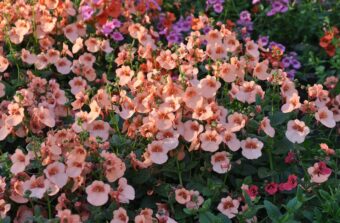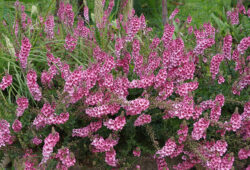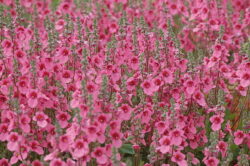In this article, we will discuss how to grow Diascias in containers. Diascias are a perennial that comes from South Africa, where 70 different species are known to exist. It has a common name of twinspur and is a relative of snapdragon. Once they were only trailers but because of recent breeding, new upright varieties are being created that have more colours and the flowers are more elegant.

The biggest problem is that they are only hardy to – 5 degrees Celsius and it is a short-lived perennial. It is best to grow this tender perennial as an annual and start afresh every year.
Diascias tend to have small, green, oval leaves and on top of which a mass of small flowers appear. The flowers can be orange, red, pink or purple. The top long petal is the distinguishing feature of the flower, along with the two side petals with horn or spur-like projections to which the plant gets its common name.
They are long-lasting blooms and if they are treated right they can be in flower all summer to autumn. This is provided you cut back flowered stems to encourage repeat blooming and you do not let the compost dry out. There are a large number of varieties from dwarves to 50cm+ tall plants.
HOW TO PLANT A DIASCIAS
Choose a container that is in dimensions with the plant you buy- a larger container for larger plants. No matter what container you choose it must have enough drainage holes or your plant will not do well. To the container place a 1cm layer of gravel at the bottom and fill the remainder with good quality, multipurpose compost. Diascias prefer to grow in slightly acidic soil, as long as it is fertile and well-draining.
Dig a hole that is slightly bigger than the original root ball and place the plant in at the same level as it was in the original container- no shallower and definitely no deeper. Backfill with the growing media and fill any gaps with more compost. Firm the plant in and water well.

Diascias tend to prefer to be grown in full sun but can take light shade, especially from the strong midday sun.
After watering continue to water regularly to help establish the plant, but not too excessively so that the soil is soggy. Water when 2.5cm below the top of the surface of the compost feels dry to the touch,
Diascias do not like hot weather and in summer the plant can look far from its best. At this time it is best to cut the plant and feed it at monthly intervals with a balanced liquid fertilizer. Once the heatwave is over the plant will spring back into life.
When you plant the Diascias, you can add a handful of slow-release fertilizer but not too much as this will lead to leggy plants. To give a truly stunning display, it is best to grow different varieties of Diascias, so they can spill over the edge with different colours.
GROWING FROM SEED
It is rare but not unheard of that you can grow Diascias from seeds. If you can find some, you will need to start them six to eight weeks before the final frost date. Make sure it is not a hybrid as it will not come true. Plant the seeds in a seed tray by filling them with seed compost and gently sprinkling the seeds on top of the compost.
Gently press the seeds in and then do not cover. Leave the seeds open to the light and air. This is because they need light to germinate. Keep it moist and after two weeks under gently heat the seeds will start to germinate.
They will then need to be pricked out into individual pots before hardening and planting outside.
PESTS AND DISEASES
Diseases are not common for Diascias, but the leaves and flowers are so attractive to snails and slugs. You will need to protect them from being munched by using woolly deterrent mats or slug pellets. Apart from that, they are not attacked by other pests and pathogens.
VARIETIES TO GROW

Many varieties can be found online and in garden centres. Here are some of the best:
‘Blackthorn Apricot’ has soft pink flowers, whilst ‘Coral Belle’, ‘Ruby Field’ and ‘Salmon Supreme’ has orangey-pink blooms. They go well with plants that have true blue, white and lime green flowers.
‘Dew Drops’ has white blooms with yellow centres, whilst ‘Flirtation Orange’ has wonderful orange flowers.
‘Pink Adobe’ is a tall variety that is more cold-resistant and has elegant, pink blooms. Others include ‘Lilac Belle’ and ‘Twinkle’ that have blue-pink flowers.
CONCLUSIONS
In this article, we have discussed how to grow Diascias in containers. They are wonderful elegant plants with blooms that are pink, red, orange or even blue.
They tend to be easy to look after, only requiring watering in dry spells, feeding and occasionally deadheading. Although it can be attacked by slugs and snails, but this does not distract it from growing this colourful, tender perennial.
If you have any questions or comments on how to grow Diascias in containers, please do so in the comment box below.
Happy Diascia growing.
